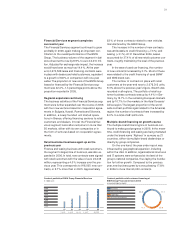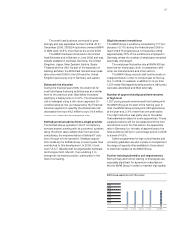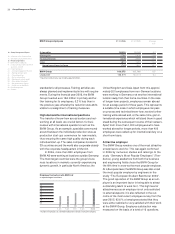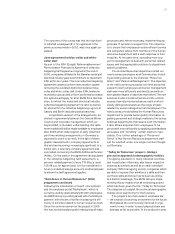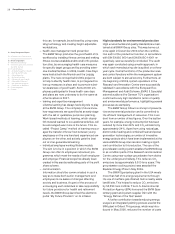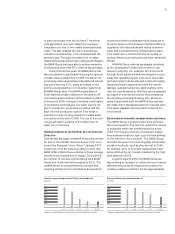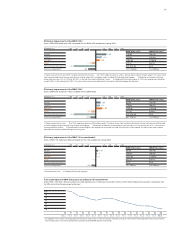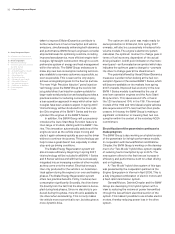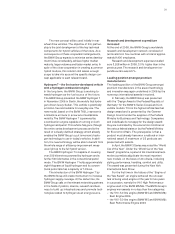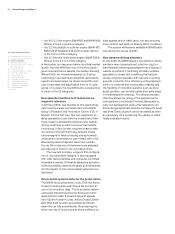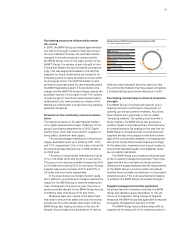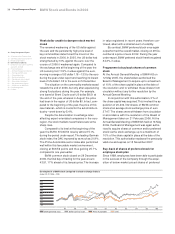BMW 2006 Annual Report Download - page 33
Download and view the complete annual report
Please find page 33 of the 2006 BMW annual report below. You can navigate through the pages in the report by either clicking on the pages listed below, or by using the keyword search tool below to find specific information within the annual report.32 Group Management Report
10 Group Management Report
10 A Review of the Financial Year
12
General EconomicEnvironment
15 Review of operations
38 BMW Stock and Bonds
41 Disclosures pursuant to §289 (4)
and §315 (4) HGB
43 Financial Analysis
43 – Internal Management System
44 – Earnings performance
46 – Financial position
48 – Net assets position
50 – Subsequent events report
50 – Value added statement
53 – Key performance figures
54 – Comments on BMW AG
58 Risk Management
62 Outlook
taken to improve EfficientDynamics contribute to
further reductions in fuel consumption and vehicle
emissions, simultaneously enhancing both dynamics
and performance. BMW Group’s engineers consider
all potential areas for optimising a vehicle, including
improved aerodynamics, more efficient engine tech-
nologies, lightweight construction through to a com-
prehensive system of energy and heat management
within the vehicle. The BMW Group endeavours to
make any new fuel consumption reducing technolo-
gies available to as many customers as possible, as
soon as possible. This is seen as the only way to
achieve ecological progress for the fleet as a whole.
The new “High Precision Injection” petrol injection
technology gives the BMW Group the world’s first
jet-guided direct fuel injection system suitable for
large-scale serial production and actually provides a
practical solution for reducing consumption using
a lean operation approach in ways which other
tech-
nologies have been unable to exploit. In spring 2007,
this technology will be introduced to the four-cylin-
der Otto engines of the BMW 1 Series and the six-
cylinder Otto engines of the BMW 5 Series.
In addition, the BMW Group will successively
introduce the Auto Start/Stop Function feature to
their range of models, starting with the BMW 1 Se-
ries. This innovation automatically switches off the
engine as soon as the vehicle stops moving and
starts it again extremely quickly as soon as the driver
wishes to continue the journey. This technology can
help to save a great deal of fuel, especially in urban
stop-and-go driving conditions.
The Brake Energy Regeneration system will
also increase efficiency. Beginning in spring 2007,
this technology will be included in all BMW 1 Series
and 5 Series vehicles and will then be successively
integrated into an increasing number of other models
as they come onto the market. Electrical energy is
then only produced for the vehicle’s on-board
elec-
trical system during the engine’s run-over and braking
phases.The Brake Energy Regeneration system
offers two practical benefits. Firstly, it reduces fuel
consumption significantly. Secondly, the driver bene-
fits directly from the fact that the alternator is decou-
pled during load phases. Since no electricity is pro-
duced during this phase, more thrust is available to
the driver when accelerating. This not only makes
the vehicle more economical to run, but also gives a
more dynamic drive.
The optimum shift point was made ready for
series production in 2006 and, from spring 2007
onwards, will also be successively introduced into
volume models.The engine’s electronics system
calculates the optimum moment to change gear in
terms of fuel economy, dependent of the actual
driving situation. A shift point indicator on the
instru-
ment panel – an illuminated arrow symbol which also
indicates the optimum gear to change to – prompts
the driver to change gear at the ideal moment.
The potential offered by these EfficientDynamics
measures is evident when looking at the fuel con-
sumption figures of the revised BMW 1 Series, which
will become available on the markets from spring
2007 onwards. Improved fuel economy in the new
BMW 1 Series models is achieved by the use of
new lean operation engines and the Auto Start/
Stop function. This saves around 14% of fuel in
the 120i and around 19% in the 118i. The revised
models of the118d and 120d diesel-engine vehicles
also require around 15% less fuel than their prede-
cessors. In this way, the BMW Group is making a
significant contribution to lowering fleet fuel con-
sumption within the context of the voluntary ACEA
commitment.
Electrification of the powertrain continues to
make progress
The BMW Group is also working on a hybrid version
of the powertrain for its high-performance models.
In cooperation with General Motors and Daimler-
Chrysler, the BMW Group is working on the develop-
ment of a “Two-Mode” hybrid drive-system capable
of reducing fuel consumption by up to 20 %.The
new system offers for the first time an increase in
efficiency and performance, both for urban driving
and on highways.
A “Two-Mode” hybrid drive system of this type
was presented by the cooperation partners at the
Engine Symposium in Vienna in April 2006.This is
a fully integrated combination of electric motors and
a fixed-ratio transmission system.
General Motors, DaimlerChrysler and the BMW
Group are developing this hybrid system with a
view to reducing the volume of power transmitted
through the less efficient electrical section of the
system.This makes it possible to use smaller electric
motors, thereby reducing power loss in the drive
system.



